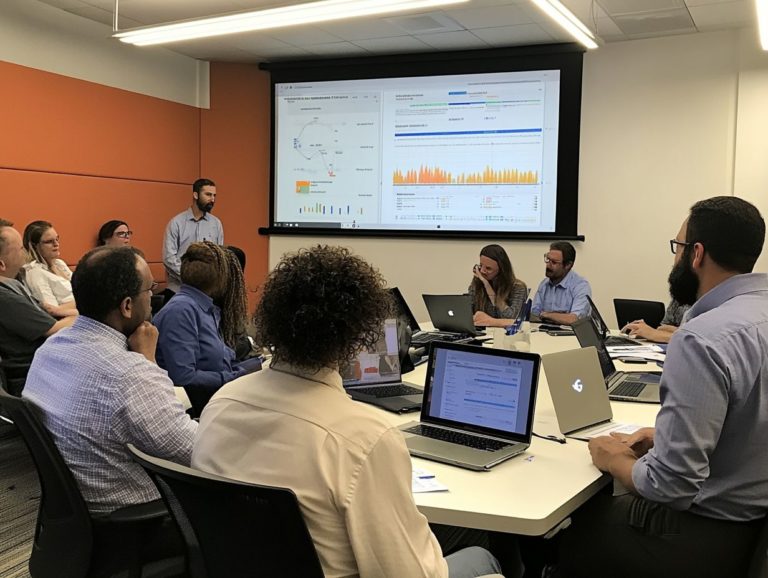5 reasons to invest in vulnerability assessment services
In today’s digital landscape, the security of your systems is paramount. Act now to protect your vital information!
How can you ensure you re shielded from potential threats? Discover five powerful reasons to invest in vulnerability assessment services.
By identifying system weaknesses, prioritizing security measures, and ensuring compliance with regulations, security checks are essential for safeguarding your organization.
You ll learn about the process, different types, and best practices, equipping you with the expertise needed to elevate your security strategy.
Dive in to uncover how proactive measures can save you time and resources while fortifying your defenses against cyber attacks.
Contents
- Key Takeaways:
- 1. Uncover Hidden Weaknesses in Your System
- 2. Helps Prioritize Security Measures
- 3. Compliance with Regulations and Standards
- 4. Protects Against Cyber Attacks
- 5. Saves Time and Resources
- What Is a Vulnerability Assessment and How Does It Work?
- What Are the Different Types of Vulnerability Assessments?
- How Often Should a Vulnerability Assessment Be Conducted?
- What Are the Steps Involved in a Vulnerability Assessment?
- What Are the Common Vulnerabilities That Are Identified in a Vulnerability Assessment?
- What Are the Best Practices for Addressing Vulnerabilities Identified in a Vulnerability Assessment?
- Frequently Asked Questions
- What is a vulnerability assessment service?
- Why invest in vulnerability assessments?
- How often should vulnerability assessments be performed?
- What is the difference between vulnerability assessments and penetration testing?
- Who should perform vulnerability assessments?
- How can I choose the right vulnerability assessment service for my organization?
Key Takeaways:

- Identify weaknesses before they are exploited.
- Prioritize security measures to allocate resources effectively.
- Stay compliant with regulations through regular assessments.
1. Uncover Hidden Weaknesses in Your System
Conducting a vulnerability assessment is crucial for identifying potential weaknesses in your cybersecurity framework, especially within your critical systems and IT infrastructure.
This ensures that sensitive data in the healthcare sector is adequately safeguarded against cyber threats.
These assessments typically employ a variety of methodologies, including automatic tools that check your networks for weaknesses. For instance, a prominent healthcare provider recently identified a critical flaw in their patient management system through automated scans, leaving sensitive patient records vulnerable to unauthorized access.
By pinpointing these gaps, you not only mitigate immediate threats but also enhance compliance with standards like HIPAA, which demands rigorous security measures to protect patient information.
Ultimately, thorough vulnerability assessments are integral to your organization s broader risk management strategy, promoting a proactive approach to cybersecurity that can significantly reduce the likelihood of costly data breaches.
2. Helps Prioritize Security Measures
A well-executed vulnerability assessment does more than just highlight weaknesses; it enables you to prioritize security measures based on the potential impact of various cyber threats and vulnerabilities.
Incorporating penetration testing into this process provides invaluable insights into the actual attack vectors that cybercriminals might exploit. This hands-on approach enables you to simulate real-world attacks, revealing not only theoretical weaknesses but also the vulnerabilities that could be exploited in practice.
As a result, you can focus your investments on the most critical areas, ensuring that resources are allocated effectively to mitigate risks that could disrupt operations and compromise sensitive data.
This dual strategy enhances your organization s resilience against the ever-evolving landscape of cyber threats.
3. Compliance with Regulations and Standards
Regular vulnerability assessments are crucial for ensuring compliance with stringent healthcare regulations like HIPAA and GDPR.
These assessments help you maintain a strong security posture while adapting to the ever-evolving regulatory landscape.
By systematically identifying and addressing security weaknesses, you can implement essential security best practices, enabling you to better protect sensitive data from breaches that could result in significant financial consequences and reputational harm.
Staying ahead in vulnerability management not only enhances data privacy but also builds trust among your clients and stakeholders.
Ultimately, this dedication to compliance and security fosters a culture of accountability and continuous improvement, ensuring you are well-prepared to navigate the intricate world of regulatory requirements.
4. Protects Against Cyber Attacks

Vulnerability assessments are essential for safeguarding your organization against cyber attacks. They help you identify security weaknesses that hackers could exploit, enhancing your overall cyber resilience.
With cyber threats evolving daily, it s crucial to act fast. By conducting regular assessments, you can uncover gaps in your defenses that might otherwise serve as inviting entry points for attackers.
This dual approach strengthens your defenses and ensures quick responses to weaknesses. Coupling these assessments with robust incident response strategies allows for a swift reaction when breaches occur.
This minimizes potential damage and secures your sensitive data against future threats.
5. Saves Time and Resources
Implementing regular vulnerability assessments can lead to significant cost savings and improved operational efficiencies by preventing security incidents that might otherwise disrupt your business operations. For a deeper understanding, consider exploring the landscape of vulnerability assessment services.
By identifying potential weaknesses before they can be exploited, you shield your organization from the financial fallout of data breaches and protect your hard-earned reputation.
A proactive approach to security assessments allows you to streamline your security management processes. By allocating resources wisely, you boost your security and stay ahead of threats.
This strategic allocation enhances your overall security posture, allowing for a more focused response to actual threats. It ultimately fosters a culture of continuous improvement and resilience against ever-evolving cyber risks.
What Is a Vulnerability Assessment and How Does It Work?
A vulnerability assessment is a systematic approach that evaluates your organization s IT networks and systems to identify security flaws. It ultimately enhances your cybersecurity posture and informs your ways to handle potential security issues.
The primary goal of vulnerability assessments is to uncover potential weaknesses before hackers can exploit them, safeguarding sensitive data and maintaining operational integrity.
This process involves various methodologies to ensure comprehensive coverage. You can utilize automated scanning tools, which are software that checks for known weaknesses in your systems automatically, alongside manual testing techniques that offer a deeper analysis of specific system configurations and user behaviors.
By integrating both automated and manual approaches, your organization can develop a more robust security management framework. This allows you to prioritize remediation efforts and allocate resources effectively while fostering a culture of continuous improvement in your security practices.
What Are the Different Types of Vulnerability Assessments?
You’ll find several types of vulnerability assessments, each designed to tackle specific IT security challenges. These include network vulnerability assessments, web application assessments, and penetration testing.
Network vulnerability assessments primarily focus on uncovering weaknesses within your organization s network infrastructure. They utilize an array of tools and techniques to identify open ports, misconfigurations, and outdated software that could leave you exposed.
Web application assessments focus on the security of your online platforms. Their goal is to unearth vulnerabilities like SQL injection and cross-site scripting, which could jeopardize your data.
Penetration testing is a method that tests your security by pretending to be a hacker. By simulating real-world attacks, you can see how well your defenses stand up against malicious intruders.
When you combine these distinct methodologies, you gain a comprehensive view of your organization s security posture. This enabled perspective allows your team to craft thorough remediation strategies that address a broader spectrum of potential threats.
How Often Should a Vulnerability Assessment Be Conducted?

The frequency with which you conduct vulnerability assessments hinges on a variety of factors, including industry regulations, the ever-changing threat landscape, and your organization’s unique risk management strategy.
This helps you stay compliant and secure.
To uphold strong security measures, prioritizing these evaluations in your routine operations is essential. Regular assessments identify weaknesses. They also help you update your security measures, allowing you to tackle emerging threats effectively.
As your IT infrastructure evolves whether through the introduction of new technologies or applications the need for frequent evaluations becomes even more critical to protect against vulnerabilities that may arise from these changes.
Compliance with regulations also stresses the need to follow set schedules to effectively mitigate risks.
What Are the Steps Involved in a Vulnerability Assessment?
A comprehensive vulnerability assessment requires several essential steps, including asset discovery, vulnerability scanning, risk analysis, and remediation efforts that bolster your cybersecurity defenses.
These phases are crucial for pinpointing weaknesses within your organization’s network and systems, paving the way for targeted enhancements. Asset discovery allows you to catalog all resources, ensuring that no critical component slips through the cracks.
Next, you perform a vulnerability scan, utilizing advanced tools to automate the identification of potential threats, revealing areas that demand your immediate attention.
Next comes risk analysis, where you evaluate the likelihood and impact of these vulnerabilities, helping you prioritize which issues to tackle first.
Finally, remediation is where you patch, configure, or implement necessary controls, fortifying your defenses against exploitation.
Leveraging tools like Nessus for scanning and OWASP ZAP for web application security can significantly streamline these processes, enabling you to conduct a thorough assessment and establish a robust security posture.
What Are the Common Vulnerabilities That Are Identified in a Vulnerability Assessment?
Vulnerability assessments often uncover a range of common issues, including outdated software, misconfigured systems, and security weaknesses within network protocols all potential gateways to data breaches.
One of the most notorious threats is SQL Injection, a method where attackers exploit flaws in database queries to access sensitive data. Another significant concern is Cross-site Scripting (XSS), which permits malicious scripts to execute in the user’s browser, putting personal data at risk.
Recognizing these vulnerabilities is crucial. You must take action to improve security management practices. By enhancing awareness and committing to regular updates, promptly patching systems, and conducting comprehensive security training for employees, you can significantly reduce risks and build a stronger technological environment.
Don’t wait! Start your vulnerability assessment today to secure your organization.
What Are the Best Practices for Addressing Vulnerabilities Identified in a Vulnerability Assessment?
Addressing vulnerabilities from an assessment requires commitment to best practices. Prioritize them based on their risk and implement necessary patches.
Establish a risk management framework that categorizes weaknesses according to their potential impact. This allows you to allocate resources effectively, ensuring your efforts yield the best results.
Once you have implemented patches, integrate a robust training program for employees. Teaching them to recognize and report threats significantly bolsters your overall security posture.
Schedule regular security reviews to stay vigilant against new threats. By fostering a culture of continuous improvement, you strengthen your current defenses and prepare your organization for future challenges.
This proactive stance cultivates a resilient cybersecurity environment, safeguarding your interests for the long haul.
Frequently Asked Questions

What is a vulnerability assessment service?
A vulnerability assessment service identifies and evaluates potential risks and weaknesses in a system or network. It uses tools and strategies to find weaknesses and provide recommendations for mitigating them.
Why invest in vulnerability assessments?
Investing in vulnerability assessments helps keep your data safe and saves you money! Here are some benefits, including 5 signs your vulnerability assessment needs improvement:
- Identifies potential weaknesses in your system before hackers exploit them.
- Protects your organization’s sensitive data and information.
- Ensures regulatory compliance and avoids penalties.
- Strengthens your overall security posture.
- Saves money in the long run by preventing costly data breaches.
How often should vulnerability assessments be performed?
Conduct vulnerability assessments regularly, at least once a year or after major changes to your system or network. The frequency may vary based on your industry, risk level, and compliance requirements.
What is the difference between vulnerability assessments and penetration testing?
Vulnerability assessments focus on identifying weaknesses in a system, while penetration testing involves actively exploiting those weaknesses to assess existing security measures. Vulnerability assessments are proactive, whereas penetration testing is more reactive.
Who should perform vulnerability assessments?
Vulnerability assessments should be conducted by trained professionals with knowledge in cybersecurity and risk management. You can hire an external agency or have an in-house team dedicated to these assessments.
How can I choose the right vulnerability assessment service for my organization?
When selecting a vulnerability assessment service, consider the provider’s reputation, experience, approach, and pricing. It’s also valuable to look into exploring the benefits of external vulnerability assessments to ensure the service aligns with your organization’s specific needs and compliance requirements.
Don’t wait for a breach to happen! Start your vulnerability assessment today!






